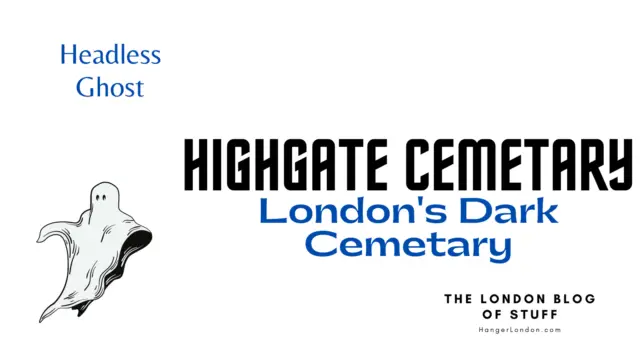The Legend of the Headless Ghost
The story of the headless ghost of Highgate Cemetery has been passed down for generations. According to the legend, the ghost is said to be the spirit of a man who was beheaded for practicing witchcraft. He is said to roam the cemetery at night, searching for his lost head.
The History of Highgate Cemetery
Highgate Cemetery is a historic burial ground located in North London, England. It was opened in 1839 by a private company, the London Cemetery Company, as a response to the overcrowding of existing burial grounds in the city. Highgate Cemetery was designed to be a place of rest for the Victorian elite, and it quickly became a popular place for burials among the wealthy and influential families of the time.
The cemetery is divided into two parts: the East Cemetery and the West Cemetery. The East Cemetery is the older of the two and was the first to be opened. It is known for its impressive array of Victorian tombs and monuments, including those of famous figures such as Karl Marx, George Eliot, and Douglas Adams.
The West Cemetery was opened in 1856 as an extension to the East Cemetery. It was designed by architect Stephen Geary and is known for its impressive architecture and elaborate tombs. The Egyptian Avenue, Circle of Lebanon, and Terrace Catacombs are all located in the West Cemetery and are some of the most famous features of the cemetery.
Over the years, Highgate Cemetery has become the final resting place for many notable figures from British history. In addition to the famous individuals buried in the East Cemetery, the West Cemetery is home to the graves of many other influential people, including actors, artists, politicians, and scientists. Some of the notable people buried in the West Cemetery include:
- Christina Rossetti, a poet, and author
- Sir Ralph Richardson, a renowned actor
- Radclyffe Hall, a writer, and LGBTQ+ icon
- Michael Faraday, a pioneering scientist
- Patrick Caulfield, a prominent artist
Highgate Cemetery has become a popular tourist destination and has been the inspiration for many works of literature and art. The cemetery’s rich history, impressive architecture, and famous inhabitants continue to draw visitors from around the world.
Egyptian Avenue in Highgate Cemetary
The Egyptian Avenue is one of the most unique and distinctive features of Highgate Cemetery’s West Cemetery. It is an underground tunnel lined with tombs and decorated with Egyptian motifs, making it a striking and unforgettable part of the cemetery.
The Egyptian Avenue was designed by architect Stephen Geary in the mid-19th century as a way to provide wealthy families with an exclusive and luxurious place to be buried. It was inspired by Geary’s travels to Egypt and the tombs he saw there, which he felt would provide a suitably grand and exotic resting place for his clients.
Construction on the Egyptian Avenue began in 1839, shortly after the opening of Highgate Cemetery. It was completed in 1854, at a time when the craze for all things Egyptian was sweeping through Europe. The avenue was designed to be an impressive and opulent space, with a grand entrance archway and a long tunnel lined with tombs.
The tombs in the Egyptian Avenue are some of the most elaborate and ornate in Highgate Cemetery. They are made from a variety of materials, including marble, granite, and sandstone, and are decorated with intricate carvings and sculptures. Many of the tombs also feature Egyptian symbols and motifs, such as the scarab beetle and the Ankh, a symbol of life.
Despite its grandeur, the Egyptian Avenue was not without controversy. Some critics felt that the use of Egyptian motifs was inappropriate and disrespectful to the culture and history of Egypt. Others felt that the avenue was an extravagant and unnecessary use of space, given that many of the tombs in the cemetery were already impressive and grandiose.
Despite these criticisms, the Egyptian Avenue remains one of the most popular and well-known parts of Highgate Cemetery. Its unique design and historical significance have made it a must-see destination for visitors to the cemetery, and it continues to inspire awe and wonder among those who walk through its grand entrance.
Hauntings on the Egyptian Avenue
The Egyptian Avenue in Highgate Cemetery is said to be haunted by the ghost of a young woman who was buried there in the 19th century. According to legend, the woman was entombed in one of the tombs along the avenue and was mistakenly declared dead. It is said that she woke up in her tomb and died from suffocation before anyone could rescue her.
The ghost of the woman is said to haunt the Egyptian Avenue, wandering along the tunnel and appearing to visitors as a misty figure. She is often described as wearing a flowing white dress and has been known to appear suddenly and disappear just as quickly.
There have been many reported sightings of the ghost over the years, with visitors to the cemetery reporting strange sensations and unexplained occurrences in the vicinity of the Egyptian Avenue. Some have reported feeling a sudden drop in temperature or hearing strange noises, while others have claimed to have seen the ghostly figure of the woman herself.
One of the most famous accounts of the haunting took place in the early 1970s, when a group of ghost hunters visited the cemetery in search of paranormal activity. They claimed to have seen the ghostly figure of the woman wandering along the avenue, and one of the members of the group even managed to capture a photograph of the apparition.
Despite the many reports of the haunting, there are those who remain skeptical. Some believe that the ghostly sightings are simply the result of overactive imaginations, while others argue that they are the result of the atmospheric conditions within the tunnel.
Regardless of whether the haunting is real or not, the legend of the ghost of the Egyptian Avenue continues to capture the imagination of visitors to Highgate Cemetery. It is a testament to the power of storytelling and the enduring appeal of ghost stories that even in the 21st century, people continue to be fascinated by the idea of a ghostly figure haunting the tunnels of the cemetery.
The Mystery of the Headless Ghost
The Headless Ghost of Highgate Cemetery is one of the most well-known ghost stories associated with the cemetery. According to legend, the ghost is said to be the spirit of a man who was buried in the cemetery without his head.
The story goes that in the 19th century, a wealthy man was buried in Highgate Cemetery in a lead-lined coffin to prevent grave robbers from stealing his body. However, after the burial, it was discovered that the man’s head was missing. It is said that the man’s family offered a large reward for the return of his head, but it was never found.
The legend of the Headless Ghost began to circulate around Highgate Cemetery shortly after the man’s burial. Visitors to the cemetery reported seeing a ghostly figure wandering around the graves, searching for its missing head. Some claimed to have seen the figure at night, while others reported seeing it during the day.
Over the years, the story of the Headless Ghost has become a part of Highgate Cemetery folklore. Many people have claimed to have seen the ghostly figure over the years, with some even reporting physical contact with the entity. Others have claimed to have captured photographic evidence of the ghost, with some images appearing to show a misty figure wandering among the graves.
Despite the many sightings and reports of the Headless Ghost, there are those who remain skeptical. Some believe that the ghostly sightings are simply the result of misidentification or hoaxes, while others argue that they are the result of overactive imaginations.
Regardless of whether the Headless Ghost is real or not, the story remains a popular and enduring part of Highgate Cemetery’s history. It is a testament to the power of folklore and the enduring appeal of ghost stories that even in the modern era, people continue to be fascinated by the idea of a headless ghost wandering among the graves of Highgate Cemetery.
The Legacy of Highgate Cemetery
Highgate Cemetery has become an iconic symbol of Victorian-era London. Its beautiful architecture, unique history, and haunting legends continue to attract visitors from around the world. The cemetery has also inspired numerous works of literature and art, including Bram Stoker’s Dracula and Pink Floyd’s album The Wall.
Highgate Cemetery, Swain’s Lane, Dartmouth Park, London Borough of Camden, London, Greater London, England, N6 6PJ, United Kingdom







